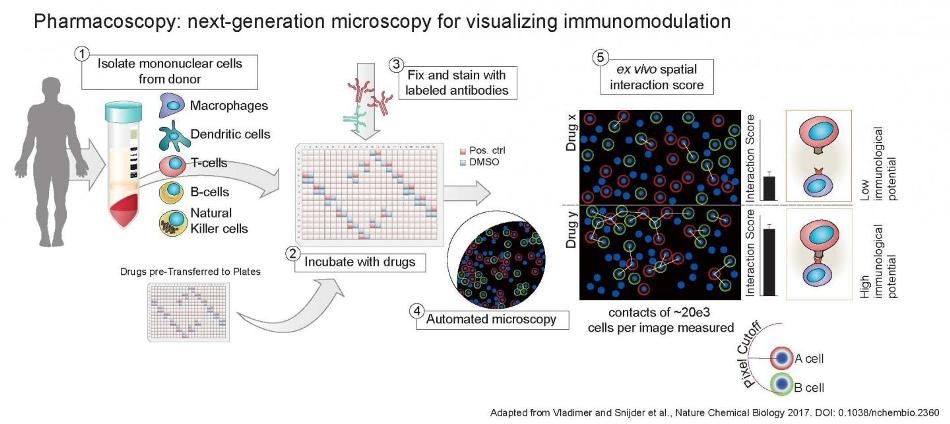Apr 25 2017
 This is a graphical abstract of the Pharmacoscopy method. (CREDIT -Vladimer Gregory/CeMM)
This is a graphical abstract of the Pharmacoscopy method. (CREDIT -Vladimer Gregory/CeMM)
The human immune system has a huge variety of cell types accomplishing diverse tasks in monitoring tissue homeostasis to eliminate damaged cells and to protect against pathogens. To guarantee the smooth and regulated functioning of this highly complex system, a fine-tuned coordination is essential that requires advanced communication.
For that reason, immune cells use a broad range of biochemical signaling pathways, triggered by soluble proteins or direct cell-cell contacts. Those pathways are also targeted by latest drugs, for example cancer immunotherapies, that direct the immune response against specific cell types or structures.
The hunt for new drugs, biological or small molecule, that impact the immune system in a desired manner is tough: immune signaling, mostly a combination of communication through soluble proteins and direct interaction by cell-cell contacts, is subtle and difficult to track in all its distinctions. Thus far, there has been a lack of rapid and powerful technology to measure the effect of a potential immunomodulatory drug specifically in a cell-cell contact dimension.
By integrating advanced high-throughput fluorescent microscopy with single cell image analysis and new analysis algorithms, Pharmacoscopy offers a powerful solution. Developed by a team of researchers at CeMM Research Center for Molecular Medicine of the Austrian Academy of Sciences led by Director Giulio Superti-Furga and examined in partnership with the Medical University of Vienna, Pharmacoscopy can quantify the total spatial patterning and direct interactions of immune cells within blood with unparalleled accuracy and speed. The technique was reported in Nature Chemical Biology (DOI:10.1038/nchembio.2360).
Joint single cell resolution and completely automated platform control, Pharmacoscopy can test large drug libraries, as available in Stefan Kubicek's PLACEBO (Platform Austria for Chemical Biology) laboratory, for compounds with immunomodulatory prospect.
We found that 10% of all approved drugs tested influence the immune system in some way - much of which was not known
Gregory Vladimer, Co-First Author of the Research
With this technique, the researchers identified Crizotinib, an FDA approved drug for non-small cell lung cancer, to have a formerly unidentified immunomodulatory potential: "With Pharmacoscopy, we could track how Crizotinib enables cytotoxic T-cells to attack cancer cells" explains Berend Snijder, the other co-first author. "The compound induces the upregulation of MHC on the surface of cancer cells, a protein complex that is recognized by T-cells and leads to their killing."
This is the world´s first method to track the modulation of the immune system at high-resolution and high-throughput. Pharmacoscopy is not only a new and powerful tool for drug discovery; it can also be implemented in basic research by visualizing the effects of signaling molecules on the immune system. In future, Pharmacoscopy should be applied to test individual patient samples on their response to various drugs - a mile stone for the development of a personalized precision medicine.
Giulio Superti-Furga, Scientific Director, CeMM